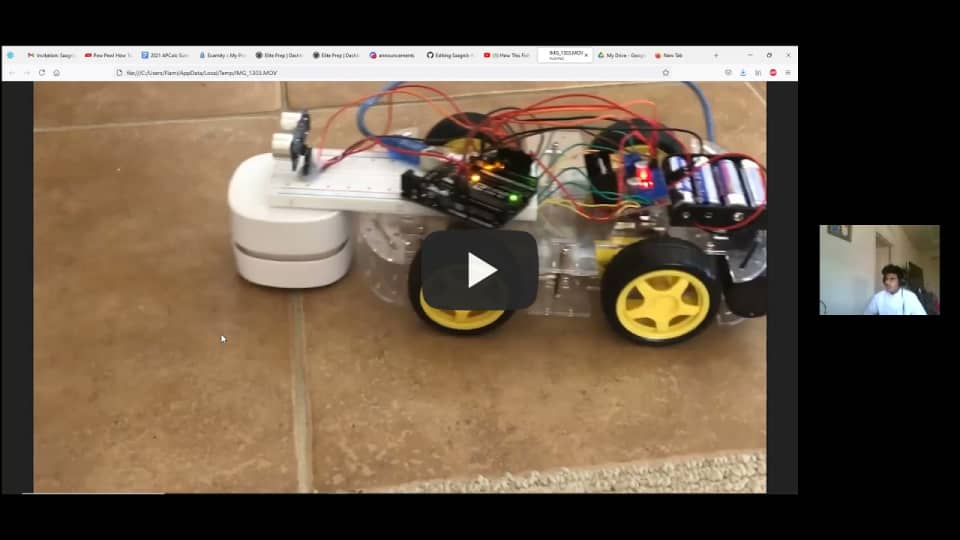Arduino Based Floor Cleaning Robot
This project uses an arduino to control a floor cleaning a robot. It utilizes an ultrasonic sensor to know when to stop and turn,and uses 4 DC motors and a motor driver to control the movement. A vacuum and a brush are attached to the car to clean the floor.
| Engineer | School | Area of Interest | Grade |
|---|---|---|---|
| Saagnik M | Amador Valley Highschool | Mechanical Engineering | Incoming Junior |

Final Presentation
Reflection
After 3 weeks at Bluestamp Engineering, I can say that I’ve learned a lot. Coming into the program, I had little experience with Arduino and the electrical aspect of things. After working hard throughout the course of the program I have learned a lot about these. I have gained an understanding about problem solving, and working through bugs. Problems such as working through the obstacle avoidance and attaching the vacuum were quite daunting at first, but with time and thinking the solutions were found. Ultimately, my experience at Bluestamp Engineering was very fruitfl and exciting. I think I gained a lot of wisdom and I it definitely fueled the passion to keep diving into mechanical engineering.
Final Milestone
The third and final milestone was just about my modification. I wanted to create a sort of chime after a certain amount of time to let the user know that the robot’s cleaning job was over with. I did the by adding a buzzer, and using the millis function which allowed me to keep track of time. In this case I made the chime the Mario theme and it played after a certain amount of time.
Final Code
#include "pitches.h"
#define melodyPin 11
int melody[] = {
NOTE_E7, NOTE_E7, 0, NOTE_E7,
0, NOTE_C7, NOTE_E7, 0,
NOTE_G7, 0, 0, 0,
NOTE_G6, 0, 0, 0,
NOTE_C7, 0, 0, NOTE_G6,
0, 0, NOTE_E6, 0,
0, NOTE_A6, 0, NOTE_B6,
0, NOTE_AS6, NOTE_A6, 0,
NOTE_G6, NOTE_E7, NOTE_G7,
NOTE_A7, 0, NOTE_F7, NOTE_G7,
0, NOTE_E7, 0, NOTE_C7,
NOTE_D7, NOTE_B6, 0, 0,
NOTE_C7, 0, 0, NOTE_G6,
0, 0, NOTE_E6, 0,
0, NOTE_A6, 0, NOTE_B6,
0, NOTE_AS6, NOTE_A6, 0,
NOTE_G6, NOTE_E7, NOTE_G7,
NOTE_A7, 0, NOTE_F7, NOTE_G7,
0, NOTE_E7, 0, NOTE_C7,
NOTE_D7, NOTE_B6, 0, 0
};
int tempo[] = {
12, 12, 12, 12,
12, 12, 12, 12,
12, 12, 12, 12,
12, 12, 12, 12,
12, 12, 12, 12,
12, 12, 12, 12,
12, 12, 12, 12,
12, 12, 12, 12,
9, 9, 9,
12, 12, 12, 12,
12, 12, 12, 12,
12, 12, 12, 12,
12, 12, 12, 12,
12, 12, 12, 12,
12, 12, 12, 12,
12, 12, 12, 12,
9, 9, 9,
12, 12, 12, 12,
12, 12, 12, 12,
12, 12, 12, 12,
};
int underworld_melody[] = {
NOTE_C4, NOTE_C5, NOTE_A3, NOTE_A4,
NOTE_AS3, NOTE_AS4, 0,
0,
NOTE_C4, NOTE_C5, NOTE_A3, NOTE_A4,
NOTE_AS3, NOTE_AS4, 0,
0,
NOTE_F3, NOTE_F4, NOTE_D3, NOTE_D4,
NOTE_DS3, NOTE_DS4, 0,
0,
NOTE_F3, NOTE_F4, NOTE_D3, NOTE_D4,
NOTE_DS3, NOTE_DS4, 0,
0, NOTE_DS4, NOTE_CS4, NOTE_D4,
NOTE_CS4, NOTE_DS4,
NOTE_DS4, NOTE_GS3,
NOTE_G3, NOTE_CS4,
NOTE_C4, NOTE_FS4, NOTE_F4, NOTE_E3, NOTE_AS4, NOTE_A4,
NOTE_GS4, NOTE_DS4, NOTE_B3,
NOTE_AS3, NOTE_A3, NOTE_GS3,
0, 0, 0
};
int underworld_tempo[] = {
12, 12, 12, 12,
12, 12, 6,
3,
12, 12, 12, 12,
12, 12, 6,
3,
12, 12, 12, 12,
12, 12, 6,
3,
12, 12, 12, 12,
12, 12, 6,
6, 18, 18, 18,
6, 6,
6, 6,
6, 6,
18, 18, 18, 18, 18, 18,
10, 10, 10,
10, 10, 10,
3, 3, 3
};
const int trigPin = 8;
const int echoPin = 9;
long duration;
int distance;
int in1 = 2;
int in2 = 4;
int enA = 3;
int enB = 6;
int in3 = 5;
int in4 = 7;
void setup() {
pinMode(11, OUTPUT);
pinMode(enA, OUTPUT);
pinMode(enB, OUTPUT);
pinMode(in1, OUTPUT);
pinMode(in2, OUTPUT);
pinMode(in3, OUTPUT);
pinMode(in4, OUTPUT);
pinMode(trigPin, OUTPUT);
pinMode(echoPin, INPUT);
Serial.begin(9600);
}
void loop() {
long timestart = millis();
//Serial.println(timestart);
while (millis() < timestart + 5000) {
Serial.println("In the main loop!");
digitalWrite(trigPin, LOW);
delay(2);
digitalWrite(trigPin, HIGH);
delay(10);
digitalWrite(trigPin, LOW);
duration = pulseIn(echoPin, HIGH);
distance = duration * 0.034 / 2;
Serial.print("Distance:");
Serial.println(distance);
if (distance<15) {
//Serial.println("In If 1!"); //Check to see if code has entered into the If statement
digitalWrite(in1, LOW);
digitalWrite(in2, HIGH);
analogWrite(enA, 200);
digitalWrite(in3, HIGH);
digitalWrite(in4, LOW);
analogWrite(enB, 200);
delay(1000);
if (distance<20) {
//Serial.println("In If 2!"); //Check to see if code has entered the nested if statement
digitalWrite(in1, HIGH);
digitalWrite(in2, LOW);
analogWrite(enA, 250);
digitalWrite(in3, HIGH);
digitalWrite(in4, LOW);
analogWrite(enB, 250);
delay(1000);
}
}
else {
//Serial.println("In Else!"); //Check to see if code has entered the else statement
digitalWrite(in1, HIGH);
digitalWrite(in2, LOW);
analogWrite(enA, 200);
digitalWrite(in3, LOW);
digitalWrite(in4, HIGH);
analogWrite(enB, 200);
delay(500);
}
//Serial.println(millis()); //Millis check to see how much time has passed through one loop
}
Serial.println("I made it!");
digitalWrite(in1, LOW);
digitalWrite(in2, LOW);
analogWrite(enA, 0);
digitalWrite(in3, LOW);
digitalWrite(in4, LOW);
analogWrite(enB, 0);
sing(1);
sing(1);
sing(2);
//delay(2000);
while (1);
}
int song = 0;
void sing(int s) {
song = s;
if (song == 2) {
Serial.println(" 'Underworld Theme'");
int size = sizeof(underworld_melody) / sizeof(int);
for (int thisNote = 0; thisNote < size; thisNote++) {
int noteDuration = 1000 / underworld_tempo[thisNote];
buzz(melodyPin, underworld_melody[thisNote], noteDuration);
int pauseBetweenNotes = noteDuration * 1.30;
delay(pauseBetweenNotes);
buzz(melodyPin, 0, noteDuration);
}
}
else {
Serial.println(" 'Mario Theme'");
int size = sizeof(melody) / sizeof(int);
for (int thisNote = 0; thisNote < size; thisNote++) {
int noteDuration = 1000 / tempo[thisNote];
buzz(melodyPin, melody[thisNote], noteDuration);
int pauseBetweenNotes = noteDuration * 1.30;
delay(pauseBetweenNotes);
buzz(melodyPin, 0, noteDuration);
}
}
}
void buzz(int targetPin, long frequency, long length) {
long delayValue = 1000000 / frequency / 2;
long numCycles = frequency * length / 1000;
for (long i = 0; i < numCycles; i++) {
digitalWrite(targetPin, HIGH);
delayMicroseconds(delayValue);
digitalWrite(targetPin, LOW);
delayMicroseconds(delayValue);
}
}
Second Milestone
My second milestone was the completion of the base project without any mods. This included tying in the ultrasonic sensor, motors, motordriver, and the obstacle avoidance code together.The glueing down of the battery and establishing of the arduino and motor driver on the chassis was also included. Finally, I also attached the desktop vacuum to the robot by sticking it underneath a breadboard. Tying everything together and anchoring it with the code, the arduino-based floor cleaning robot was ready to go and was completed. Looking towards the next milestone, I am thinking of adding some modifications in the future.
First Milestone
My first milestone was getting my wiring set up for the motor driver and motors, and the ultrasonic sensor. I also wanted to test the range of the ultrasonic sensor and calibrate it properly. Lastly, I completed the assembly of the chassis of the car as well. I got my ultrasonic sensor wire to the arduino and test it properly with a set of code. Afterwards, I assembled the chassis of the car and put the motors on the wheels. Then, I moved onto to the DC motors and the motor driver. I hooked up the motors to the motor driver and tested the motors going both forwards and backwards. Now I felt confident with the parts that I had, and was ready to move on.

Ultrasonic Sensor Circuit and Code

const int trigPin = 12;
const int echoPin = 13;
long duration;
int distance;
void setup() {
pinMode(trigPin, OUTPUT);
pinMode(echoPin,INPUT);
Serial.begin(9600);
}
void loop() {
digitalWrite(trigPin, LOW);
delay(2);
digitalWrite(trigPin, HIGH);
delay(10);
digitalWrite(trigPin, LOW);
duration = pulseIn(echoPin, HIGH);
distance = duration*0.034/2;
Serial.print("Distance:");
Serial.println(distance);
}
Motor Driver Circuit and Code

int in1 = 2;
int in2 = 4;
int enA = 3;
void setup() {
pinMode(enA, OUTPUT);
pinMode(in1, OUTPUT);
pinMode(in2, OUTPUT);
}
void loop() {
digitalWrite(in1, HIGH);
digitalWrite(in2, LOW);
analogWrite(enA, 200);
delay(1500);
digitalWrite(in1, LOW);
digitalWrite(in2, LOW);
analogWrite(enA, 0);
delay(500);
digitalWrite(in1, LOW);
digitalWrite(in2, HIGH);
analogWrite(enA, 200);
delay(1500);
}


